Mitsubishi Eclipse
| Mitsubishi Eclipse | |
|---|---|
 | |
| Overview | |
| Manufacturer |
Mitsubishi Motors Diamond-Star Motors |
| Production | 1989–2011[1] |
| Model years | 1990–2012 |
| Assembly | Normal, Illinois, U.S. |
| Body and chassis | |
| Class | Sport compact (S) |
| Body style |
2-door liftback coupe 2-door convertible |
| Chronology | |
| Predecessor | Mitsubishi Cordia |
The Mitsubishi Eclipse is a sport compact car that was produced by Mitsubishi between 1989 and 2011.[1] A convertible body style was added during the 1996 model year. The Eclipse was named after an unbeaten 18th-century English racehorse which won 26 races.[2] It was also named after the astronomical event of the same name (as hinted in television commercials in Japan). It has also been rebadged and sold as the Eagle Talon and the Plymouth Laser captive imports through Mitsubishi Motors' close relationship with the Chrysler Corporation. Their partnership was known as Diamond-Star Motors, or DSM, and the vehicle trio through the close of the second-generation line is sometimes referred to by the moniker "DSM" among enthusiast circles. In Japan, the first two generations were sold at a specific Japanese retail chain called Mitsubishi Car Plaza.
The Eclipse was officially marketed in North America, Oman, South Korea, the Philippines, Brazil, Saudi Arabia, Kuwait, UAE, and China. At the end of August 2011, the final Eclipse rolled off the assembly line, and was auctioned off, the proceeds donated to charity.[3] It was not related to the Mitsubishi FTO while having a similar marketing approach.
The Eclipse underwent four generations: the first two generations (1G and 2G) share the automobile platform and parts with the Eagle Talon, and the Plymouth Laser, while the third generation (3G) shared a redesigned platform with the Chrysler Sebring and Dodge Stratus. During May 2005, the fourth, and final, generation (4G) Eclipse was introduced, replacing the Chrysler platform used in the first three generations with the PS platform.[4]
First Generation (1G) (1989–1994)
| First generation | |
|---|---|
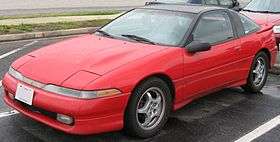 | |
| Overview | |
| Also called | DSM, 1G |
| Production | 1989–1994 |
| Model years | 1989-1994 |
| Body and chassis | |
| Class | Sport compact (S) |
| Body style | 3-door liftback coupé |
| Layout | Front-engine, front-/all-wheel drive |
| Platform | Chrysler D platform |
| Related |
Mitsubishi Galant Eagle Talon Plymouth Laser |
| Powertrain | |
| Engine |
1.8 L 92 hp (69 kW) I4 2.0 L 135 hp (101 kW) I4 2.0 L 180 hp (130 kW) I4 turbo 2.0 L 195 hp (145 kW) I4 turbo |
| Transmission |
5-speed manual 4-speed automatic |
| Dimensions | |
| Wheelbase | 2,470 mm (97.2 in) |
| Length | 4,390 mm (172.8 in) |
| Width | 1,690 mm (66.7 in) |
| Height |
1,310 mm (51.4 in) GSX: 1,300 mm (52 in) |
| Curb weight |
Base: 1,145 kg (2,524 lb) GS Turbo:1,245 kg (2,745 lb) GSX: 1,404 kg (3,095 lb) |
Overview

The first generation Mitsubishi Eclipse was marketed as an entry to mid-level four-cylinder sports coupe. Four trim levels were available; all were front-wheel drive except the premium model which was all-wheel drive. The top FWD and the AWD model were equipped with turbocharged engines.
The first generation Eclipse underwent minor styling changes during its production; 1992–1994 models have updated sheetmetal and are easily distinguishable from earlier model years. The most notable is that the 1990-1991 models have pop-up headlights, whereas the later model years do not. The Eclipse was revised for the 1995 model year as the second generation.
The Plymouth Laser model was dropped after the 1994 model year, leaving only the Eclipse and Talon to continue for the second generation.
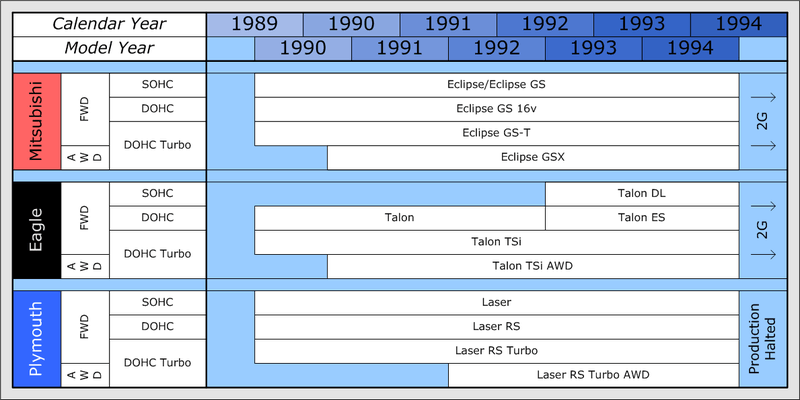
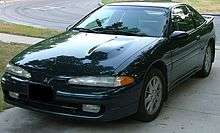
Trim levels
The Eclipse was available in five trim levels during its first-generation production run. AWD models were not available until halfway through the first model year.
- Eclipse: Base model equipped with a 92 hp (69 kW) naturally aspirated 1.8 L 8-valve SOHC 4G37 engine
- Eclipse GS: Upgraded model with slightly more equipment
- Eclipse GS DOHC: Upgraded model equipped with a 135 hp (101 kW) naturally aspirated 2.0 L 16-valve DOHC Mitsubishi Sirius engine#4G63 naturally aspirated variant of the 4G63T engine**
- Eclipse GS DOHC AWD: Equipped with a 150 hp (110 kW) 4G63 16-valve naturally aspirated engine (AWD N/A only available in Europe) All were only available with 5-speed manual transmission and without rear limited slip differential. Sunroof, cruise control, ABS, central locking and A/C were in base.
- Eclipse GS Turbo: Upgraded model equipped with a 180-195 hp* turbocharged 2.0 L 16-valve DOHC 4G63T engine
- Eclipse GSX: AWD model equipped with a 180-195 hp* turbocharged 2.0 L 16-valve DOHC 4G63T engine
* The 1990 GS Turbo with a manual transmission was rated at 190 hp, whereas the 1990 GSX with a manual transmission was rated at 195 hp (145 kW). This was for the purpose of offsetting the additional weight of the AWD mechanism (approximately 2,930 lbs Vs 2,570 lbs GVW). However, 1991 and later years of both turbo models standardized on the 195 hp version 4G63T. The automatic models were rated at 180 hp (130 kW) due to smaller fuel-injectors and turbocharger.
** 1990–1994 model years Eclipse, Talon and Laser did not come with the 420a engine, which was not added until the second generation.
These models varied significantly in drivetrains and available options, and included some variance in appearance, as higher trim lines added different front and rear fascia panels and surrounding trim, with the GSX model getting a notably different styling package from the others.
Powertrain
The basic driveline layout of the Eclipse is a transverse-mounted 4-cylinder Mitsubishi 4G37 or 4G63 engine situated on the left-hand side of the car driving an automatic or manual transmission on the right-hand side. AWD models have a different transmission which includes a limited-slip center differential and output shaft for a transfer case, which drives the rear differential (also available as limited-slip) and half-shafts.
There is also a difference between rear axle/rear ends on all-wheel-drive models. 1990-early 1992 cars have three bolts attaching the axle to the wheel hub. Late 1992–1994 have larger-diameter axles and attach to the hub with bigger, 4-bolt axle cups.
Engines
The 4G37 and 4G63 engines are both inline-four gasoline engines. The 4G63 is composed of an iron engine block and aluminum cylinder head and is equipped with 2 balance shafts for smooth operation. The turbocharged version of the 4G63 (sometimes referred to as the 4G63T) is equipped with a lower compression ratio (7.8(8.5 in 1992-1994) vs. 9.0 in the naturally aspirated version) and oil squirters under the pistons in order to better cope with the stress and extra heat caused by forced induction. The turbocharged 4G63 engine received an internal update during the 1992 model year. The engines built from 1989 through April 1992 have 6-bolt motors. Beginning in May 1992, Mitsubishi revised the engine to a 7-bolt design. The bolts refer to the number of bolts on the flywheel that connect to the crankshaft. The original 6-bolt design is generally regarded as a stronger engine due the bolt design as well as thicker connecting rods. There were a variety of other misc. differences between the two engines as well.[5]
Safety
The National Highway Traffic Safety Administration (NHTSA) has determined crash test ratings of the 1G Eclipse:[6]
| Model year | Model | Frontal driver rating | Frontal passenger rating |
|---|---|---|---|
| 1990 | Eclipse | ||
| 1991 | Eclipse | ||
| 1992 | Eclipse | ||
| 1993 | Eclipse | ||
| 1994 | Eclipse |
Awards
The Eclipse Turbo was on Car and Driver magazine's Ten Best list for 1989–1992.
Second Generation (2G) (1995–1999)
| Second generation | |
|---|---|
 | |
| Overview | |
| Also called | DSM, 2G |
| Production | 1995–1999 |
| Body and chassis | |
| Class | Sport Compact |
| Body style |
2-door convertible 2-door liftback |
| Layout | Front-engine, front-/all-wheel drive |
| Platform | Chrysler PJ platform |
| Related |
Eagle Talon Mitsubishi Galant |
| Powertrain | |
| Engine |
2.0 L 140 hp (100 kW) I4 2.4 L 141 hp (105 kW) I4 2.0 L 227 hp (169 kW) turbo I4 |
| Transmission |
4-speed automatic 5-speed manual |
| Dimensions | |
| Wheelbase | 2,510 mm (98.8 in) |
| Length |
1995-96: 4,370 mm (172.2 in) 4,380 mm (172.4 in) |
| Width | 1,740 mm (68.7 in) |
| Height |
1995-96: 1,280 mm (50.2 in) Spyder: 1,340 mm (52.8 in) GSX: 1,280 mm (50.5 in) 1997-99: 1,260 mm (49.8 in) |
| Curb weight |
RS/GS: 1,235 kg (2,723 lb) GS-T:1,305 kg (2,877 lb) GSX:1,460 kg (3,210 lb) Spyder GS: 1,310 kg (2,888 lb) Spyder GS-T: 1,385 kg (3,053 lb) |
Overview
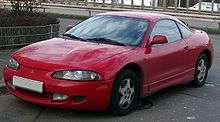

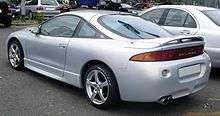
The Eclipse was completely redesigned in 1995 and now came with standard dual air bags, more rounded styling, a larger interior and a new engine made by Chrysler for the base model. The second generation car maintained the market focus of the first generation car but had numerous changes to appeal to a broader market. A convertible model, named the Eclipse Spyder, was introduced in 1996 offered in two trim levels; the GS and the GS-T. The Spyder GS was powered by a 2.4L I-4 naturally aspirated 4G64 engine. The Spyder GS-T was fitted with Mitsubishi's turbocharged 4G63 engine. The GSX model was also powered by this engine but with the addition of a high performance all wheel drive system. No convertible model was powered by the Chrysler's 420a engine, nor was there a convertible with all-wheel-drive.
The turbocharged engine option continued as the 4G63. It was also updated for more power as compared to the previous generation (227 hp vs 195 hp). The naturally aspirated cars had two different I-4 engines depending on the market they were produced for. The US version engines were producing 140 hp, found only in the RS and GS trims, was a modified version of the Chrysler Neon engine, the 420a, manufactured by Chrysler and delivered to and installed at the Diamond Star Motors facility. The European market engines were a naturally aspirated 4G63 with 141 hp (105 kW; 143 PS). US-market Eclipses made less horsepower than their Japanese domestic market relatives when equipped with the 4G63 (210 hp, 154 hp), due to emissions regulations at the time.
The Talon was discontinued in 1998, along with the rest of the Eagle line, leaving only the Eclipse for sale during the 1999 model year.
As the width dimension and larger engines were offered to Japanese consumers, it was now regarded as a luxury car, as this generation no longer complied with Japanese Government dimension regulations, and Japanese consumers were liable for annual taxes as a result, which affected sales.
A special version of the Eclipse, called the "10th Anniversary OZ Rally", was sold at the end of the 1999 model run with unique 16-inch Enkei wheels with the OZ Racing logo. It also included the leather interior package, accented exhaust exit, and hoop-style spoiler that were available as standard equipment on GS-T and GSX models. The special edition package was only offered with the 420A engine.
A unique version of the 2G Eclipse was sold in some European countries. It used a naturally aspirated Mitsubishi 4G63 motor, similar to what was available in the 1G, unique sideview mirrors, and amber rear turn signals.
1997 facelift
A minor style revision was applied for the 1997 model year. The front grille opening was given a more aggressive profile. The headlights were given a sharper slant on the inner edges, and the previous all-chrome fixture interior changed to a black interior with chrome reflector inserts. The driving lights were revised from a reflector type to a smaller projection type. The rear bumper cap was altered and had the reverse lights restyled and moved out into the bumper fascia, away from their original central position by the license plate bracket. The GS-T and GSX received a large rear spoiler. The interior color choices also changed from blue, and grey in 1995–1996 model years to black/grey, tan/black, and grey in the 1997–1999 model years. The black leather interior option was only available in 1999; the package included all seats (with the 'Mitsubishi' logo embroidered on both of the fronts), door inserts, and center console armrest.

Trim levels
The Eclipse was available in seven trim levels: Base [Only available in 1996.5 (mid-model year)], RS (Rally Sport), GS (Grand Sport), GS Spyder, GS-T (Grand Sport Turbo), GS-T Spyder, and GSX (Grand Sport X=AWD).
- Eclipse RS: Base model equipped with a 140 hp and 130 lbs./ft. of torque 2.0 L 16-valve DOHC Chrysler 420a engine
- Eclipse GS: Equipment upgraded model equipped with a 140 hp (100 kW) and 130 lbs./ft. of torque 2.0 L 16-valve DOHC Chrysler 420A engine. The European variant of the GS had a naturally aspirated, DOHC 16 valve 4G63 engine producing 150 HP
- Eclipse Spyder GS: Convertible model equipped with a 141 hp (105 kW) 2.4 L 16-valve SOHC Mitsubishi 4G64 engine
- Eclipse GS-T: Upgraded model equipped with a 210 hp (160 kW) and 214 lbs./ft. of torque turbocharged and intercooled 2.0 L 16-valve DOHC Mitsubishi 4G63 engine
- Eclipse Spyder GS-T: Convertible model equipped with a 210 hp (160 kW) and 214 lbs./ft. of torque turbocharged and intercooled 2.0 L 16-valve DOHC Mitsubishi 4G63 engine
- Eclipse GSX: AWD model equipped with a 210 hp (160 kW) and 214 lbs./ft. of torque turbocharged and intercooled 2.0 L 16-valve DOHC Mitsubishi 4G63 engine
Powertrain
The basic driveline layout of the Eclipse is a transverse-mounted 4-cylinder Chrysler 420A, Mitsubishi 4G64 or 4G63 engine. The Mitsubishi motors are mounted in the same orientation as the first generation cars. The 420a-powered cars had the engine mounted on the right side of the car, and further back in the chassis. AWD models had a similar transmission to the first generation car. The second generation GSX also had a stronger carrier/differential when equipped with the limited slip option. The 5-speed transmission uses a pneumatic shifter linkage, also known as the "Air-assisted" hydraulic shifter linkage one of a kind set up made famous by The Fast and Furious movie. Mitsubishi created the AAH Shifter Linkage to help with a more precision feeling and audible connection with the transmission.
Engines
All motors are four-cylinder gasoline engines. All have cast iron blocks with aluminum cylinder heads. The 4G63/4G64 engines retain the balance shafts for smoother operation, while the 420a does not use them. The 1995–1999 turbo engines were given an increased compression ratio of 8.5:1, up from 7.8:1, and a smaller turbo, a Garrett T25 set to 12psi in place of the previous Mitsubishi TD04-13G (automatic cars) and TD05-14B (manual cars). This was done to minimize turbo lag, which was an undesirable trait for mass-market appeal in the U.S. These changes led to increased horsepower and torque vs. the previous 1G turbos. The 2G turbo cars produced 210HP @ 6000rpm (205HP @ 6000rpm w/ AT) and 214 lbs./ft. @ 3000rpm (220 lbs./ft. @ 3000rpm w/ AT.)
The 4G63 engines found in 1990–1994 models have a 60 mm throttle body compared to the 1995–1999 MY's 52 mm. The intake ports on the head and runners of the intake manifold are also larger on the 1G. They also have larger crankshaft bearing journals to allow better lubrication. Because they look similar, it is important to note that the 1990-1994 cylinder head is more on the side of high air volume, while the 1995-1999 cylinder head is more on the side of high air velocity.
Mitsubishi Motors quietly updated its 4G63 engine in 1998 and 1999. The crankshaft is more precisely shaved and cut compared to previous years. It is identical to that used in the Mitsubishi Lancer Evolution, which was not yet sold in North America until 2003. The thrust bearings have been revised to a "split" type to allow better lubrication and self-alignment with the crankshaft. It also had improved tuning & functionality, thanks to a new ECU, which was similar to Lancer Evolution ECUs. Although originally deactivated to protect the drivetrain, it included advanced features such as launch control, boost control, adjustable rev-limit, fuel system control and even fuel and boost map selection for certain Mitsubishi Heavy Industries turbochargers.
Transmissions
All 2G Eclipses were available with either a 4-speed automatic transmission (AT) or a 5-speed manual transmission. The automatic transmission equipped 4G63 cars weighed 80 pounds (36 kg) more than the manual transmission equipped vehicles. The gearing and final drive ratios would vary depending on engine and model.[7]
| Gears | RS, GS | GS Spyder | GS-T | GSX | GSX AT |
|---|---|---|---|---|---|
| 1st | 3.54 | 3.166 | 3.090 | 3.083 | 2.551 |
| 2nd | 2.13 | 1.833 | 1.833 | 1.684 | 1.488 |
| 3rd | 1.36 | 1.240 | 1.217 | 1.115 | 1.000 |
| 4th | 1.03 | 0.896 | 0.888 | 0.833 | 0.685 |
| 5th | 0.81 | 0.731 | 0.741 | 0.666 | N/A |
| Reverse | 3.42 | 3.166 | 3.166 | 3.166 | 2.176 |
| Final | 3.94 | 3.625 | 4.153 | 4.929 | 4.359 |
The difference in gearing between the 5-speed GS-T vs. the GSX would result in a lower gear limited top speed for the GSX than the GS-T. However, many GS-Ts came with an ECU limited top speed of 130 mph due to GS-T cars being equipped with H-rated tires.
Problems and issues
The 2G Eclipse received numerous Technical Service Bulletins (TSB) affecting a variety of issues with the car however there was one notable powertrain recall. In March 1998, Mitsubishi issued a recall (bulletin 98V069001) for all 1990-1998 Mitsubishi Eclipse GSXs citing, "Lockup of the transfer case can occur due to insufficient lubrication. The condition can cause a loss of vehicle control increasing the risk of a crash." The dealers would inspect the vehicles for adequacy of the transfer case oil volume, transfer case oil leakage, and operational degradation of the transfer case mechanism. The transfer case itself did not leak but rather the brass plug in the center of the transfer case yoke would leak. Mitsubishi estimated 24,275 vehicles were affected.[8]
Another issue that impacted the mid 1995-1997 Eclipse GS-T/GSX (4G63 equipped vehicles) is thrust bearing failure commonly referred to in the Eclipse community as "crankwalk." Mitsubishi never publicly addressed the issue via a recall or TSB. There were a variety of symptoms however the most common symptom of crankwalk is the clutch pedal would stick to the floor upon making a left turn. If crankwalk occurred, it typically meant engine failure. In 1998, Mitsubishi revised manufacturing processes to correct the issue.
Safety
All 2G Eclipses came standard with driver and front-passenger air bags, side-guard door beams, front and rear body structure crumple zones, 5 mph energy absorbing bumpers, safety-cage body construction, 4- wheel disc brakes (except RS), three-point ELR/ALR lap/shoulder safety belts (ELR only for driver) and height adjustable front shoulder belts. Anti-lock brakes was optional on all models (except for RS).
The National Highway Traffic Safety Administration (NHTSA) has determined crash test ratings of the 2G Eclipse:[6]
| Model year | Model | Frontal driver rating | Frontal passenger rating | Side driver rating |
|---|---|---|---|---|
| 1995 | Eclipse | N/A | ||
| 1996 | Eclipse Spyder | N/A | ||
| 1997 | Eclipse | N/A | ||
| 1998 | Eclipse | N/A | N/A | |
| 1999 | Eclipse | N/A | N/A |
Awards
1995 "Driver's Choice Award" - MotorWeek[9]
1996 "Driver's Choice Award" - MotorWeek
Third Generation (3G) (2000–2005)
| Third generation | |
|---|---|
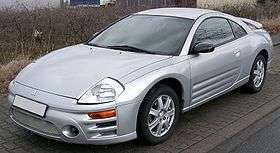 | |
| Overview | |
| Production | 2000–2005 |
| Model years | 1998-2005 |
| Body and chassis | |
| Class | Sport compact |
| Body style |
2-door convertible 2-door liftback |
| Layout | FF layout |
| Platform | Chrysler ST-22 platform |
| Related |
Mitsubishi Galant Chrysler Sebring coupe Dodge Stratus coupe |
| Powertrain | |
| Engine |
2.4 L 150 hp (110 kW) I4 2.4 L 150 hp (110 kW) I4 3.0 L 200 hp (150 kW) V6 3.0 L 210 hp (160 kW) V6 |
| Transmission |
4-speed automatic 5-speed manual |
| Dimensions | |
| Wheelbase | 2,560 mm (100.8 in) |
| Length |
2004-05: 4,491 mm (176.8 in) 2000-03: 4,455 mm (175.4 in) |
| Width | 1,750 mm (68.9 in) |
| Height |
2001-05 Coupe: 1,311 mm (51.6 in) Spyder: 1,341 mm (52.8 in) 2000: 1,316 mm (51.8 in) |
| Curb weight |
2.4 coupe: 1,280 kg (2,822 lb) 2.4 convertible: 1,380 kg (3,042 lb) V6 coupe: 1,385 kg (3,053 lb) V6 convertible: 1,470 kg (3,241 lb) |
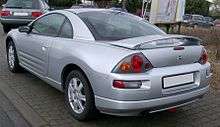
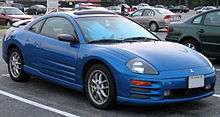
Overview
The Eclipse underwent a change into its third generation in 1999, closely applying the Mitsubishi SST design study which debuted at the 1998 North American International Auto Show. It was the first concept vehicle exhibited by Mitsubishi at an auto show in the U.S.[10]
Two new powertrain options were available, a 147 hp 2.4 L 16-valve SOHC 4-cylinder 4G64 and a 205 hp 24v SOHC 3.0 L V6 (6G72). AWD was no longer an option. The suspension setup was adjusted to provide a softer and more compliant ride quality.
The third generation Eclipse shared its powertrain with the 8th generation Galant. In late 2001, power of the GT trim was lowered to 200 hp (150 kW) as a result of tightened emission standards forcing MMNA to adopt the California emissions standards for all variants of the car, rather than selling independent 'Fed Spec' and 'Cali Spec' versions.
In mid-2002, the GTS trim was introduced for the 2003 model year. This vehicle included an engine with a 10:1 compression ratio, revised camshaft profile and an improved Mitsubishi Variable Induction Management (MVIM) air intake system that gave the car an extra 10 hp (7.5 kW) and a slightly improved power curve. The 2003–2005 GTS coupe, GTS Spyder and GT Spyder[11] shared the new engine while the GT coupe retained the 200 hp (150 kW) powertrain.
With the introduction of the 2003 GTS model, the Eclipse saw minor changes including a redesigned front bumper with slotted fog lights, as well as a recoloring of the tail lights. On the interior, the gauge face changed, and the door panels were also redesigned. Newly designed five-spoke chrome wheels were offered with the GT and GTS trims.
Trim levels
The Eclipse was available in 7 trim levels: RS, GS, GS Spyder, GT, GT Spyder, GTS, and GTS Spyder. All trim levels (besides Spyder) came with an automatic tilt and retracting sunroof. All models were FWD. The GTS trims were introduced for the 2003 model year. For the 2005 model year, the RS trim was discontinued and a special "Remix Edition" GS trim package was introduced, which included chrome wheels, identifying placards and the premium interior package from the GT and GTS models, which was not previously offered on the GS trim.
- Eclipse RS: Base model equipped with a 154 hp 2.4 L 16-valve SOHC Mitsubishi 4G64 engine; automatic RS models were only 3G Eclipse without Mitsubishi's "sportronic" select-shift option[12]
- Eclipse GS: Upgraded model equipped with a 154 hp 2.4 L 16-valve SOHC Mitsubishi 4G64 engine
- Eclipse GS Spyder: Convertible model equipped with a 154 hp 2.4 L 16-valve SOHC Mitsubishi 4G64 engine
- Eclipse GT: Upgraded model equipped with a 200 hp 3.0 L 24-valve SOHC Mitsubishi 6G72 engine
- Eclipse GT Spyder: 2000-2002: convertible model equipped with a 200 hp 3.0 L 24-valve SOHC Mitsubishi 6G72 engine. 2003-2005: convertible FWD model equipped with a 210 hp 3.0 L 24-valve SOHC Mitsubishi 6G72 engine with MVIM[12]
- Eclipse GTS: Upgraded model equipped with a 210 hp 3.0 L 24-valve SOHC Mitsubishi 6G72 engine with Mitsubishi Variable Induction Management (MVIM)
- Eclipse GTS Spyder: Convertible model equipped with a 210 hp 3.0 L 24-valve SOHC Mitsubishi 6G72 engine with MVIM
Engines
The third generation Eclipse utilized two distinct Mitsubishi engines: The SOHC 4G64 2.4 L 16-valve four-cylinder and SOHC 6G72 3.0 L 24-valve V6. Both engines use cast iron blocks with aluminum cylinder heads. The four-cylinder, found in the RS, GS and GS Spyder trims, used a 9:1 compression ratio and produced an output of 154 hp and 163 ft-lbs throughout all years.[11] Despite being a Sirius engine, it shares more components with the 4G63 found in the 2003-2004 Lancer Evolution than the four-cylinder found in previous generations of Eclipse.
The 3.0 L V6, however, found in GT and GT Spyder models, produced 205 hp in Fed Spec between 2000-2001 and 200 hp in all GT models in Cali Spec, all years with a static compression ratio of 9:1. In 2003, the 3.0 L V6 was improved for the GTS and GT/GTS Spyder, using a revised camshaft profile, raised compression ratio of 10:1 and variable-length MVIM intake manifold. This engine produced 210 hp.
Safety
The National Highway Traffic Safety Administration (NHTSA) has determined crash test ratings of Eclipse of different model years:[6]
| Model year | Model | Type | Frontal driver rating | Frontal passenger rating | Side driver rating | 4x2 Rollover |
|---|---|---|---|---|---|---|
| 2002 | Eclipse | 2-DR | ||||
| 2003 | Eclipse | 2-DR | ||||
| 2004 | Eclipse | 2-DR | N/A | |||
| 2005 | Eclipse | 2-DR | N/A |
2001 Mitsubishi Eclipse EV
The Mitsubishi Eclipse EV is a prototype electric vehicle with a lightweight electric motor and lithium-ion batteries in the chassis of a third generation Eclipse. It is powered by manganese lithium-ion batteries made by Japan Storage Battery, which have 65% reduced charging time over nickel-hydrogen batteries.
It participated in the 2001 Shikoku EV Rally, a 780 km circuit around the perimeter of Shikoku, Japan, where it drove in excess of 400 km on a single battery charge.[13]
Fourth Generation (4G) (2006–2012)
| Fourth generation | |
|---|---|
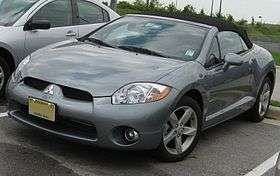 | |
| Overview | |
| Production | 2005-2011 |
| Model years | 2006-2012 |
| Body and chassis | |
| Body style |
2-door convertible 3-door coupe |
| Layout | FF layout |
| Platform | Mitsubishi PS platform |
| Related |
Mitsubishi Endeavor Mitsubishi Galant |
| Powertrain | |
| Engine |
2.4 L 162 hp (121 kW) I4 3.8 L 263 hp (196 kW) V6 |
| Transmission |
4-speed automatic 5-speed automatic 5-speed manual 6-speed manual |
| Dimensions | |
| Wheelbase | 2,576 mm (101.4 in) |
| Length |
2006-08: 4,564 mm (179.7 in) 2009-2011: 4,583 mm (180.4 in) |
| Width | 1,834 mm (72.2 in) |
| Height |
2006-2010: 1,359 mm (53.5 in) 2006–2010 Spyder: 1,382 mm (54.4 in) 2006–2010 GT Spyder: 1,389 mm (54.7 in) 2011: 1,351 mm (53.2 in) 2011 Spyder: 1,375 mm (54.1 in) |
| Curb weight |
2.4 coupe 1,485 kg (3,274 lb) V6 coupe 1,575 kg (3,472 lb) 2.4 convertible 1,575 kg (3,472 lb) V6 convertible 1,665 kg (3,671 lb) |
Overview
Another substantial styling revision was introduced, with the new model taking some of the profile from the second generation model but maintaining a front fascia consistent with Mitsubishi's current corporate styling features. Drivetrain features of the new model include a 263 hp (196 kW) 3.8 L MIVEC V6 for the GT trim, 2009 and newer models have 265 hp. The GS has a 162 hp (121 kW) 2.4 L MIVEC four-cylinder, both derived from the Mitsubishi PS platform family, with which the Eclipse shares many mechanical components. Like the 2004 Galant and third generation Eclipse, the new Eclipse is FWD only, although a concept model has been produced by Mitsubishi and Ralliart with a MillenWorks designed hybrid-electric AWD platform, the 4G63 engine from the Lancer Evolution, and more aggressive body styling with imitation carbon fiber accents.[14] The V6 produces 263 hp (196 kW) and 260 ft·lbf (350 N·m) of torque.
The fourth-generation Spyder (convertible) Eclipse was released for the 2007 model year at the North American International Auto Show.
Trim levels
For the 2010 model year in the U.S., its primary market, the Eclipse was available in five trim levels: GS, GS Sport Spyder, SE, GT, and GT Spyder. In Mexico, the GT Spyder is known as the Eclipse Convertible. In Canada, the GT trim is known as the GT-P.
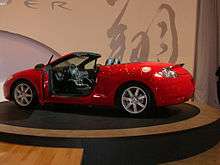
- Eclipse GS Sport Spyder: Convertible model equipped with a 162 hp (121 kW) 2.4 L 16-valve SOHC Mitsubishi 4G69 engine
- Eclipse SE: Upgraded model equipped with a 162 hp (121 kW) 2.4 L 16-valve 4-cylinder MIVEC Engine, and additional features including 18 inch wheels, a front and rear spoiler, unique interior options and side skirt decals.
- Eclipse GT: Premium model equipped with a 263 hp 3.8 L 24-valve SOHC Mitsubishi 6G75 engine, 2009–2012 models have 265 hp
- Eclipse GT Spyder: Convertible premium model equipped with a 263 hp 3.8 L 24-valve SOHC Mitsubishi 6G75 engine, 2009–present models have 265 hp
The models and standard / optional equipment:
- GS Standard- Choice of five-speed manual or a four-speed Sportronic automatic transmission, a 140-watt (max.) Mitsubishi CD/MP3-compatible audio system with six speakers, 17-inch alloy wheels, an anti-theft immobilizer, auto-off halogen headlamps, power windows/locks/mirrors, air conditioning, a split fold-down rear seat, two 12-volt accessory outlets, anti-lock brakes, a rear spoiler, and a six airbag safety system.
Options Include - Sun & Sound package with a power sunroof is paired with a 650-watt (max.) Rockford Fosgate audio system. Boasting nine speakers including a 10-inch (250 mm) trunk-mounted subwoofer, a 6-CD in-dash changer, and steering wheel-mounted audio controls, the package also includes a center display with outside temperature and compass readings and an electrochromic rear-view mirror.
- GS Spyder - available for sale for the 2007 model year.
Options Include - GS Deluxe Leather Package: Leather front seating surfaces. Heated front seats. Heated side mirrors. Outside temperature indicator and compass in center dash display.
- GT Standard- Choice of six-speed manual or a five-speed Sportronic automatic transmission, a 140-watt (max.) Mitsubishi CD/MP3-compatible audio system with six speakers, 17-inch alloy wheels, an anti-theft immobilizer, auto-off halogen headlamps, fog lamps, power windows/locks/mirrors, air-conditioning, a split fold-down rear seat, two 12-volt accessory outlets, 4-wheel anti-lock disc brakes, a rear spoiler, dual-stage six airbag safety system, traction control, a front strut tower bar, and a center display with outside temperature and compass readings.
Options Include- Premium Sport Package with 18 in (460 mm) seven-spoke alloy wheels, leather front seating surfaces, a power sunroof, an eight-way-adjustable (six power) driver's seat, alloy pedals, heated front seats, heated door mirrors, automatic dimming rear-view mirror, air-conditioning and a 650-watt (max.) Rockford Fosgate audio system with nine speakers, including a 10-in (254 mm) trunk-mounted subwoofer, a 6-CD/MP3-compatible in-dash changer, steering wheel-mounted audio controls.
- GT Spyder - available for sale for the 2007 model year.
Options Include - GT Premium Sport Package: 18-inch Alloy wheels. Leather front seating surfaces. 6-way power driver's seat. Heated front seats. Heated side mirrors. Aluminum pedals. Automatic climate control. Wind Deflector
Facelifts
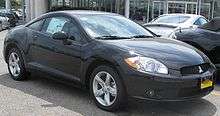
The Mitsubishi Eclipse was given a minor facelift for the 2009 model year, the front fascia changed the fog lights and deleted the triangle housing the "three diamond" logo used to sit on in the grille; the rear fascia changed the "Eclipse" insignia from an indent to raised silver letters. An option to add a dual exhaust and projector H.I.D. headlamps also became available. The V6 engine now rated at 265 hp and 262 lb-ft torque in part due to the more open front facia as well as a new stock dual exhaust system.[15] It was unveiled at the 2008 Chicago Auto Show.
For 2011, the Mitsubishi Eclipse featured a "blackout" roof, similar to the 1990 version. Mitsubishi also lowered the suspension of Eclipse about half an inch to create a lower center of gravity.[16] A rear backup camera and Bluetooth hands free calling to the Sun and sound package were included. In the GS trim, the car gets the same 18-inch wheels and blackout front end as the GT model called the GS Sport.[17]
Final model year
For the 2012 model year, the Mitsubishi Eclipse receives three (slight) changes: Brake override logic, a clear lip spoiler on the GT trim, and one new exterior color. This was the final model year, albeit a short run because production ended in August 2011.[18][19]
The last Eclipse to roll off the assembly line was built in August 2011, painted Kalapana Black, its color was chosen from by members of Mitsubishi’s Facebook community, who picked from a historical Eclipse color palette. This was the only Eclipse equipped with both the 3.8L/265 hp V-6 engine and the commemorative SE package, as well as special 18-inch Dark Argent alloy wheels and one of a kind graphics. It is also built with a sunroof, leather interior, 650W Rockford Fosgate 9-speaker audio system with Sirius XM, hands free Bluetooth phone interface, rear-view camera, and HID headlights.
The car was auctioned off by Mecum Auctions in St. Charles, IL on 17 September 2012, for $35,000.[20] Proceeds went to the Japanese Red Cross to aid victims of the 2011 Tōhoku earthquake and tsunami.[21]
Grand total Eclipse production was 906,876 units.[22]
Motorsport
All four generations of the Eclipse have been used in auto racing since its release in 1989 and has won countless victories against manufacturers of all marques. When correctly built and tuned, the Eclipse can become a very formidable opponent on the race track. This is due to its highly tunable engine, responsive AWD drivetrain and as well as having a nearly limitless selection of easy-to-find, relatively inexpensive, high performance parts. To this day, it continues to be used in automobile racing and many performance parts continue to be developed for it.
Rally, endurance and road racing
The Eclipse, and its Chrysler-branded counterparts, have competed in Sports Car Club of America (SCCA) events.
In 1995, an Eclipse GSX was entered into the annual 24 Hours of Daytona endurance race. It was placed on grid number 74, at the very back, which was also last place. Not only did it manage to get a near top twenty finish (24th overall), it completed the race without any issues.[23] It nearly set a new record as well, passing a total of 50 cars.[24][25] In 1998, it entered the race again but was in a lower specification class (GT3/GTS3)[26] It again completed the 24 hour race with no issues. The name of the team was Spirit of Daytona and their sponsor was Daytona Mitsubishi. Craig Conway, Eric Van Cleef and Todd Flis were the drivers.[27]
In 2004 and 2005, Greg Collier won the NASA Super Unlimited class national title in a yellow Plymouth Laser RS Turbo.[28] These wins were noted in particular because it managed to defeat purpose built Ferrari Challenge and Porsche Cup race cars.
In 2009 and 2010, an Eclipse Spyder GS-T driven by Matt Andrews and Andrew Brilliant won the Super Lap Battle Limited championship in Willow Springs, California.[29]
In 2012, a heavily built and tuned Mitsubishi Eclipse piloted by Mark Rybníček won the Czech Hill Climb championship.[30]
Drag racing
Brent Rau has won three world drag racing championships using an Eclipse; IDRC, NDRA and NHRA.[31] Many other notable names have also claimed big wins piloting Eclipses for drag racing use.[32]
Jett Racing entered a 3rd generation Eclipse for drag racing use. As of 2014, they hold the world record for the world's fastest four cylinder. The record stands at 6.57 seconds in the quarter mile with a top speed of 223 MPH. It has 1600 horsepower and is RWD. This Eclipse is capable of over 2000 bhp.[33][34]
See also
References
- 1 2 Beene, Ryan (25 April 2011). "Mitsubishi to halt U.S. production of 3 models in August". Automotive News. Retrieved 16 September 2016.
- ↑ "Facts & Figures" (PDF). Mitsubishi Motors. 2006. p. 29. Retrieved 30 July 2013.
- ↑ "Mitsubishi plans to halt U.S. production of 3 models in August". Autoweek.com. 25 April 2011. Retrieved 30 July 2013.
- ↑ "All-New 2006 Mitsubishi Eclipse Sport Coupe to Go on Sale Ahead of Schedule". Theautochannel.com. 19 May 2010. Retrieved 30 July 2013.
- ↑ "How Do I Know If My Engine is a 6-Bolt or 7-Bolt?". machv.com.
- 1 2 3 "1990–2010 Search Results by Model". NHTSA.GOV. Retrieved 2011-03-17.
- ↑ "Tranny gear ratios for DSMs". vfaq.com.
- ↑ "Mitsubishi Recall Campaign 98V069001 POWER TRAIN". automd.com.
- ↑ "Pre-Owned Profile: 1995-1999 Mitsubishi Eclipse". Autotrader.
- ↑ "Mitsubishi SST Concept Car On Display At Detroit Motor Show" (Press release). Media.mitsubishi-motors. 6 January 1998. Archived from the original on 9 August 2009. Retrieved 24 August 2014.
- 1 2 "Used 2003 Mitsubishi Eclipse Spyder GT Convertible Features & Specs". Edmunds.com.
- 1 2 "2000 Mitsubishi Eclipse - Features & Specs". edmunds.com. Retrieved 24 October 2014.
- ↑ "Latest MMC technologies and near-future goals: Mitsubishi Eclipse EV Prototype". Mitsubishi-motors.com. Retrieved 2012-12-26.
- ↑ "Mitsubishi SST Concept Car on Display at Detroit Motor Show" (PDF) (Press release). MillenWorks. 2005-11-20. Retrieved 2010-10-24.
- ↑ "2009 Mitsubishi Eclipse". Autoblog.com.
- ↑ "2011 Eclipse Coupe; Exotic Styling & More". Mitsubishicars.com. 2010. Retrieved 2010-10-24.
- ↑ "2011 Eclipse Coupe; Exotic Styling & More MPG". Mitsubishicars.com. 2010. Retrieved 2010-10-24.
- ↑ "2012 Eclipse Coupe; Exotic Styling & More MPG". Mitsubishicars.com. 2011. Retrieved 2011-03-12.
- ↑ "2012 Mitsubishi Eclipse". Autoblog.com.
- ↑ Lingeman, Jake (2011-01-09). "Mecum to auction last Mitsubishi Eclipse for earthquake relief". Autoweek. Retrieved 2012-01-02.
- ↑ "2012 Mitsubishi Eclipse SE Coupe Proceeds to benefit the Japan Red Cross". Mecum.com. Retrieved 2012-01-02.
- ↑ Hoffman, Steve (17 September 2011). "Final Eclipse fetches $35K in auction". Pantagraph.com. Retrieved 30 July 2013.
- ↑
- ↑
- ↑ "I Could Have Bought 1000 Rolexes Easily". caranddriver.com.
- ↑
- ↑ "1998 24 Hours of Daytona". racing-reference.info.
- ↑ "DSMTuners Sponsored Greg Collier "WINS" 2005 Championship". DSMtuners. Retrieved 6 October 2014.
- ↑ Super Lap Battle 2009 Champion Time Attack Mitsubishi Eclipse GST Spyder on YouTube
- ↑ 650 HP Mitsubishi Eclipse Gsx Hill Climb Rally Car - 2012 Czech Champion on YouTube
- ↑ Fastest 4 banger in the world (DSM) on YouTube
- ↑ gabytech for DSM Forums. "4G63 History in drag racing". Dsmtuners.com. Retrieved 30 July 2013.
- ↑ Fastest 4 CYL in the world / 6.57 @ 223 MPH. YouTube. 30 August 2014.
- ↑ 6-second 4G63 by JETT Racing. YouTube. 8 December 2014.
External links
| Wikimedia Commons has media related to Mitsubishi Eclipse. |
- "Mitsubishi Eclipse History". Edmunds.com. Retrieved 16 September 2016.
- "Mitsubishi Eclipse review". auto.consumerguide.com. Retrieved 2005-07-12.
| Mitsubishi automobile timeline, European market, 1980s–present | |||||||||||||||||||||||||||||||||||||
|---|---|---|---|---|---|---|---|---|---|---|---|---|---|---|---|---|---|---|---|---|---|---|---|---|---|---|---|---|---|---|---|---|---|---|---|---|---|
| Type | 1980s | 1990s | 2000s | 2010s | |||||||||||||||||||||||||||||||||
| 0 | 1 | 2 | 3 | 4 | 5 | 6 | 7 | 8 | 9 | 0 | 1 | 2 | 3 | 4 | 5 | 6 | 7 | 8 | 9 | 0 | 1 | 2 | 3 | 4 | 5 | 6 | 7 | 8 | 9 | 0 | 1 | 2 | 3 | 4 | 5 | 6 | |
| City car | i-MiEV | ||||||||||||||||||||||||||||||||||||
| Supermini | Colt | Colt | Colt | Colt | Colt | Colt | Space Star | ||||||||||||||||||||||||||||||
| Compact car | Lancer | Lancer | Lancer | Lancer | Lancer | Lancer | Lancer | ||||||||||||||||||||||||||||||
| Mid-size car | Carisma | ||||||||||||||||||||||||||||||||||||
| Galant | Galant | Galant | Galant | Galant | |||||||||||||||||||||||||||||||||
| Full-size car | Sigma | ||||||||||||||||||||||||||||||||||||
| Sport compact | Lancer Evo | Lancer Evolution | Lancer Evolution | ||||||||||||||||||||||||||||||||||
| Sports car | Eclipse | Eclipse | |||||||||||||||||||||||||||||||||||
| Grand tourer | 3000 GT | ||||||||||||||||||||||||||||||||||||
| Mini MPV | Space Star | ||||||||||||||||||||||||||||||||||||
| Compact MPV | Space Runner | Space Runner | |||||||||||||||||||||||||||||||||||
| Large MPV | Space Wagon | Space Wagon | Space Wagon | Grandis | |||||||||||||||||||||||||||||||||
| Minivan | L300 | L300 | Space Gear | ||||||||||||||||||||||||||||||||||
| Compact crossover | ASX | ||||||||||||||||||||||||||||||||||||
| Mid-size crossover | Outlander | Outlander | Outlander | ||||||||||||||||||||||||||||||||||
| Mini SUV | Pajero Pinin | ||||||||||||||||||||||||||||||||||||
| Mid-size SUV | Pajero | Pajero | Pajero Sport | ||||||||||||||||||||||||||||||||||
| Full-size SUV | Pajero | Pajero | |||||||||||||||||||||||||||||||||||
| Pickup truck | L200 | L200 | L200 | L200 | |||||||||||||||||||||||||||||||||
| Mitsubishi automobile timeline, North American market, 1980s–present | ||||||||||||||||||||||||||||||||||||||
|---|---|---|---|---|---|---|---|---|---|---|---|---|---|---|---|---|---|---|---|---|---|---|---|---|---|---|---|---|---|---|---|---|---|---|---|---|---|---|
| Type | 1980s | 1990s | 2000s | 2010s | ||||||||||||||||||||||||||||||||||
| 0 | 1 | 2 | 3 | 4 | 5 | 6 | 7 | 8 | 9 | 0 | 1 | 2 | 3 | 4 | 5 | 6 | 7 | 8 | 9 | 0 | 1 | 2 | 3 | 4 | 5 | 6 | 7 | 8 | 9 | 0 | 1 | 2 | 3 | 4 | 5 | 6 | 7 | |
| Subcompact | Precis | i-MiEV | i-MiEV | |||||||||||||||||||||||||||||||||||
| Mirage | Mirage | Mirage | Mirage | Mirage | ||||||||||||||||||||||||||||||||||
| Tredia | G4 | |||||||||||||||||||||||||||||||||||||
| Compact | Mirage | Lancer | Lancer | |||||||||||||||||||||||||||||||||||
| Galant | Galant | Galant | ||||||||||||||||||||||||||||||||||||
| Sigma | Diamante | |||||||||||||||||||||||||||||||||||||
| Mid-size | Galant | Galant | ||||||||||||||||||||||||||||||||||||
| Diamante | ||||||||||||||||||||||||||||||||||||||
| Sport compact | Cordia | Eclipse | Eclipse | Eclipse | Eclipse | |||||||||||||||||||||||||||||||||
| Lancer Evolution | Lancer Evolution | |||||||||||||||||||||||||||||||||||||
| Sports car | Starion | 3000GT | ||||||||||||||||||||||||||||||||||||
| Compact MPV | Expo LRV | |||||||||||||||||||||||||||||||||||||
| Large MPV | Space Wagon | Expo | ||||||||||||||||||||||||||||||||||||
| Minivan | Vanwagon | |||||||||||||||||||||||||||||||||||||
| Compact crossover | Outlander Sport / RVR | |||||||||||||||||||||||||||||||||||||
| Mid-size crossover | Outlander | Outlander | Outlander | |||||||||||||||||||||||||||||||||||
| Endeavor | ||||||||||||||||||||||||||||||||||||||
| Mid-size SUV | Montero Sport | Montero Sport | ||||||||||||||||||||||||||||||||||||
| Full-size SUV | Montero | Montero | Montero | Montero | ||||||||||||||||||||||||||||||||||
| Pickup | Mighty Max | Mighty Max | Raider | L200 | L200 | |||||||||||||||||||||||||||||||||
| Vehicle is not available in the United States or Canada | ||||||||||||||||||||||||||||||||||||||